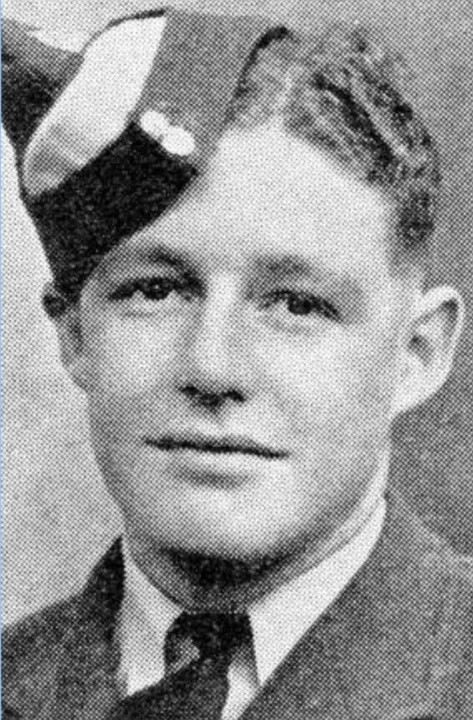Petone Man Among Kiwi War Heroes Honoured By Dutch Village
A small village in the Netherlands has honoured five airmen of the Second World War, including two New Zealanders who lost their lives when their bomber was attacked on only its second operational flight.

Air Gunner Sergeant Jack Leslie Jury
Local researcher Bas Bruls has spent years piecing together the last mission of Vickers Wellington bomber BJ767, No. 75 (New Zealand) Squadron Royal Air Force.
It was attacked by a German night fighter aircraft on 12 August 1942, and went down not far from the village of Vaals, which lies near the border with Germany.
Air Gunner Sergeant Jack Leslie Jury, from Petone, was among those on board. He and the aircraft’s pilot, Acting Flight Lieutenant Laurence St George Dobbin from Taranaki, were killed in an explosion as Acting Flight Lieutenant Dobbin tried to crash-land the plane. The other three crew members had bailed out on the pilot’s orders and were captured by the Germans.
More than 60 years later, on 9 November 2023, the date of Acting Flight Lieutenant Dobbin’s birthday, village schoolchildren unveiled a plaque bearing the names of the five crew, mounted on a substantial stone near the crash site.
Mr Bruls said the ceremony drew a large crowd from the village, who observed a minute’s silence, and a small brass band played the national anthems of the Netherlands and New Zealand.
“I told the crowd about the crash and what had happened. We had a flag from Taranaki flying, received from the Dobbin family, and it will be donated to the primary school here in Vaals,” he said.
“Children from the primary school read letters from the Dobbin family, including a letter from Lorraine Dobbin, who was named after Laurence.”
Mr Bruls diligently uncovered the full story of the bomber crew and the crash, using eyewitness testimony, accounts from the surviving aircrew, archives, documents, newspaper clippings, letters, history books and on-the-ground research.
Wellington BJ767, flying from RAF Feltwell with a crew of five, was on a mission to Mainz, Germany, when an enemy night fighter aircraft attacked, setting the plane on fire.
Acting Flight Lieutenant Dobbin told the crew to jettison the bomb load but they were unable to do so. He ordered the crew to bail out, but Sergeant Jury had a parachute malfunction and didn’t jump.
The last crew member to bail out, Sergeant Albert Elson, said Acting Flight Lieutenant Dobbin told him he would not jump while Sergeant Jury was on board, and he would instead try and crash-land the plane.
But the aircraft’s bomb load exploded, sending debris raining down on a Vaals meadow. The explosion was so large it tore the roof off a nearby farmhouse.
Sergeant Jury and Acting Flight Lieutenant Dobbin’s bodies were later recovered and they were buried locally.
Front gunner and bomb aimer Sergeant Jury was only 20 when he was killed. It was his fourth operational flight, having served with No. 75 (New Zealand) Squadron for one month.
According to Mr Brul’s research, Sergeant Jury wanted to enlist before he was old enough to do so.
“He begged and begged his father to sign the papers to allow him to go off, until eventually he relented and signed.
“Jack had deep auburn hair, which was very curly, and was known as ‘Red’ among his aircrew,” he said.
Before the war, Acting Flight Lieutenant Dobbin had trained as a teacher and represented Taranaki in rugby. Eight days before he departed for England, he married fellow teacher Majorie Stainland. He wrote to her every week, with his last letter arriving on 7 August 1942.
Murray Dobbin, Acting Flight Lieutenant Dobbin’s nephew, organised the delivery of a Taranaki rugby flag to be flown at the unveiling.
Although relatives couldn’t be there, he said many family members have visited both graves in the past and would likely travel to see the plaque one day.
“We have thanked Bas profusely for what he’s done. A plaque on a great big boulder, it just makes sure what happened will be remembered,” Mr Dobbin said.
“We are very appreciative to the Vaals area for this, and to the people who have tended the graves for the last 80-odd years.”


 Health Coalition Aotearoa: New Bill A Vital Step Towards Tobacco-Free Future In Aotearoa
Health Coalition Aotearoa: New Bill A Vital Step Towards Tobacco-Free Future In Aotearoa National Youth Theatre: 140 Christchurch Kids Shine In National Youth Theatre’s Historic CATS Premiere
National Youth Theatre: 140 Christchurch Kids Shine In National Youth Theatre’s Historic CATS Premiere NZ Symphony Orchestra: NZSO To Tour Masterworks By Mozart, Beethoven, Haydn And More
NZ Symphony Orchestra: NZSO To Tour Masterworks By Mozart, Beethoven, Haydn And More Journal Of Public Health: Vape Shops Cluster Around Schools
Journal Of Public Health: Vape Shops Cluster Around Schools Timaru District Council: Aigantighe Art Gallery Hosts An Iconic Robin White Touring Exhibition
Timaru District Council: Aigantighe Art Gallery Hosts An Iconic Robin White Touring Exhibition Victoria University of Wellington: Dame Winnie Laban Awarded Honorary Doctorate Recognising Achievements For Pasifika
Victoria University of Wellington: Dame Winnie Laban Awarded Honorary Doctorate Recognising Achievements For Pasifika 